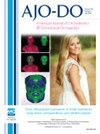英国10-14岁学龄儿童错颌和同伴关系:一项横断面研究。
IF 3
2区 医学
Q1 DENTISTRY, ORAL SURGERY & MEDICINE
American Journal of Orthodontics and Dentofacial Orthopedics
Pub Date : 2025-05-23
DOI:10.1016/j.ajodo.2025.04.017
引用次数: 0
摘要
这是一项横断面观察性研究,在英国东南部的16所学校进行,采用基于地理位置和同意参与的方便样本,旨在调查10-14岁学龄儿童错颌畸形与同伴关系的关系。方法:采用孤独感与学校不满问卷、Rosenberg自尊量表和错颌影响问卷(MIQ)对同伴关系、自尊和口腔健康相关生活质量(OHRQoL)进行测量。采用正畸治疗需求-美学成分指数(ion - ac)评估错牙合的审美影响和正畸治疗需求。结果:收集了698名参与者的完整资料。明确需要正畸治疗的学龄儿童(ion - ac, 8-10)报告的孤独感水平较高(P = 0.036), OHRQoL较低(P结论:女孩错颌与同伴关系之间存在显著关系,自尊调节了这一关系。本文章由计算机程序翻译,如有差异,请以英文原文为准。
Malocclusion and peer relationships in school children aged 10-14 years in the United Kingdom: A cross-sectional study
Introduction
This was a cross-sectional observational study carried out in 16 schools in the Southeast of the United Kingdom using a convenience sample based on geographic location and agreement to participate, aiming to investigate the relationship between malocclusion and peer relationships in school children aged 10-14 years.
Methods
Peer relationships, self-esteem, and oral health–related quality of life (OHRQoL) were measured using 3 questionnaires: the Loneliness and School Dissatisfaction Questionnaire, the Rosenberg Self-Esteem Scale, and the Malocclusion Impact Questionnaire (MIQ). The esthetic impact of malocclusion and orthodontic treatment needs were assessed using the Index of Orthodontic Treatment Need-Aesthetic Component (IOTN-AC).
Results
Complete data were collected for 698 participants. School children with a definite need for orthodontic treatment (IOTN-AC, 8-10) reported higher levels of loneliness (P = 0.036) and lower OHRQoL (P <0.001), but there was no difference in self-esteem compared to those with IOTN-AC score 1-7. The relationship between malocclusion and loneliness was fully mediated through OHRQoL (P <0.001) and moderated by self-esteem in girls so that mediation was evident in people with low and average self-esteem but not high self-esteem. In boys, as there was no direct relationship between malocclusion and loneliness, mediation did not occur.
Conclusions
A significant relationship was found between malocclusion and peer relationships in girls, and this was moderated by self-esteem.
求助全文
通过发布文献求助,成功后即可免费获取论文全文。
去求助
来源期刊
CiteScore
4.80
自引率
13.30%
发文量
432
审稿时长
66 days
期刊介绍:
Published for more than 100 years, the American Journal of Orthodontics and Dentofacial Orthopedics remains the leading orthodontic resource. It is the official publication of the American Association of Orthodontists, its constituent societies, the American Board of Orthodontics, and the College of Diplomates of the American Board of Orthodontics. Each month its readers have access to original peer-reviewed articles that examine all phases of orthodontic treatment. Illustrated throughout, the publication includes tables, color photographs, and statistical data. Coverage includes successful diagnostic procedures, imaging techniques, bracket and archwire materials, extraction and impaction concerns, orthognathic surgery, TMJ disorders, removable appliances, and adult therapy.

 求助内容:
求助内容: 应助结果提醒方式:
应助结果提醒方式:


